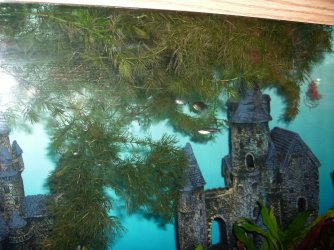I have a heavily planted 20 gallon long with Eco Complete substrate and a 48W full-spectrum LED light running a 16/8 day/night cycle with night light. I am also using Seachem fertilizer and Fritz Aquatics trace elements, and weekly 40% water changes. I have a piece of Mopani wood in the tank, which adds a barely perceptible tea-color (hence tannins) to the water. This tank has been running for several months, and I did not have any trouble growing floating hornwort for a long time, in fact I always had more new growth than I knew what to do with.
The past couple of weeks the situation has really changed. It is now barely possible to keep hornwort from doing any better than numerous short starts of new, branching growth, which then halts and the stems older parts turn brown, threatening a die off., before another mini-recovery starts. But the trend in down and down.
Red Water Lily prospering well, over a dozen pads, & making more; Valisneria sending out runners & getting VERY tall, Water onion looks OK & is splitting-off pups; "Marimo moss" balls (as found at Petsmart, etc, likely not the real thing) seem to do fine; Java fern doing OK, not great; Java moss just holding on; Aponogeton not doing too well, dying back like the hornwort.
The situation seemed to improve temporarily with a water change, or for no real reason, but this last water change (Saturday) had no effect, or made things worse(?).
I have taken to increasing the fertilizer & trace dose by adding every other day, knowing this might just as likely make things worse or cause some other problem.
I have also reduced the light intensity to 60%, as I read somewhere "moderate' light is generally better, and at 48W, my LED light is maybe overkill on a 20 gallon tank.
Any and all ideas appreciated!
More tank specifics below:
My ph is generally 7.4 - 7.6, which seems a little high to me, but the reading I've done on the subject recently seems to favor this, in contrast to what I remember from years ago.
The tank is very well filtered and aerated,; AquaClear 20-50 gal HOB, 2 sponge filters, in rear corners& on 2 air-pumps.
My nitrogen cycle readings are negligible, and the make-up water is definitely hard, so the KH & Gh remain within the bounds acceptable to the fish.
Temp is 74F, maintained by a heater
Also in the tank:
3 Corys
3 Yoyo Loaches,
1 pleco
1 Chinese Algae Eater
1 Black Ghost Knife, about 4-1/2 inches.
12 ghost shrimp
2 large nerite snails,
1 Rabbit snail
Hundreds of burrowing Malaysian Trumpet snails, mainly staying in the substrate.
The past couple of weeks the situation has really changed. It is now barely possible to keep hornwort from doing any better than numerous short starts of new, branching growth, which then halts and the stems older parts turn brown, threatening a die off., before another mini-recovery starts. But the trend in down and down.
Red Water Lily prospering well, over a dozen pads, & making more; Valisneria sending out runners & getting VERY tall, Water onion looks OK & is splitting-off pups; "Marimo moss" balls (as found at Petsmart, etc, likely not the real thing) seem to do fine; Java fern doing OK, not great; Java moss just holding on; Aponogeton not doing too well, dying back like the hornwort.
The situation seemed to improve temporarily with a water change, or for no real reason, but this last water change (Saturday) had no effect, or made things worse(?).
I have taken to increasing the fertilizer & trace dose by adding every other day, knowing this might just as likely make things worse or cause some other problem.
I have also reduced the light intensity to 60%, as I read somewhere "moderate' light is generally better, and at 48W, my LED light is maybe overkill on a 20 gallon tank.
Any and all ideas appreciated!
More tank specifics below:
My ph is generally 7.4 - 7.6, which seems a little high to me, but the reading I've done on the subject recently seems to favor this, in contrast to what I remember from years ago.
The tank is very well filtered and aerated,; AquaClear 20-50 gal HOB, 2 sponge filters, in rear corners& on 2 air-pumps.
My nitrogen cycle readings are negligible, and the make-up water is definitely hard, so the KH & Gh remain within the bounds acceptable to the fish.
Temp is 74F, maintained by a heater
Also in the tank:
3 Corys
3 Yoyo Loaches,
1 pleco
1 Chinese Algae Eater
1 Black Ghost Knife, about 4-1/2 inches.
12 ghost shrimp
2 large nerite snails,
1 Rabbit snail
Hundreds of burrowing Malaysian Trumpet snails, mainly staying in the substrate.



